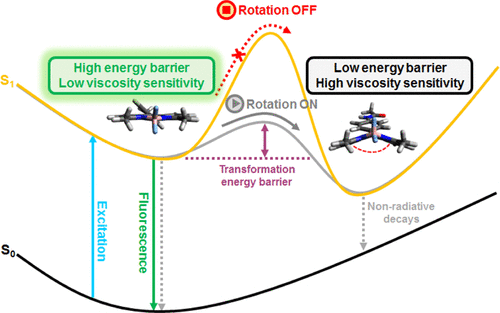Our official English website, www.x-mol.net, welcomes your feedback! (Note: you will need to create a separate account there.)
Molecular Mechanism of Viscosity Sensitivity in BODIPY Rotors and Application to Motion-Based Fluorescent Sensors.
ACS Sensors ( IF 8.9 ) Pub Date : 2020-02-27 , DOI: 10.1021/acssensors.9b01951 Xiao Liu 1, 2 , Weijie Chi 3 , Qinglong Qiao 4 , Siddhant V Kokate 5 , Eduardo Peña Cabrera 5 , Zhaochao Xu 4 , Xiaogang Liu 3 , Young-Tae Chang 1, 2
ACS Sensors ( IF 8.9 ) Pub Date : 2020-02-27 , DOI: 10.1021/acssensors.9b01951 Xiao Liu 1, 2 , Weijie Chi 3 , Qinglong Qiao 4 , Siddhant V Kokate 5 , Eduardo Peña Cabrera 5 , Zhaochao Xu 4 , Xiaogang Liu 3 , Young-Tae Chang 1, 2
Affiliation

|
Viscosity in the intracellular microenvironment shows a significant difference in various organelles and is closely related to cellular processes. Such microviscosity in live cells is often mapped and quantified with fluorescent molecular rotors. To enable the rational design of viscosity-sensitive molecular rotors, it is critical to understand their working mechanisms. Herein, we systematically synthesized and investigated two sets of BODIPY-based molecular rotors to study the relationship between intramolecular motions and viscosity sensitivity. Through experimental and computational studies, two conformations (i.e., the planar and butterfly conformations) are found to commonly exist in BODIPY rotors. We demonstrate that the transformation energy barrier from the planar conformation to the butterfly conformation is strongly affected by the molecular structures of BODIPY rotors and plays a critical role in viscosity sensitivity. These findings enable rational structure modifications of BODIPY molecular rotors for highly effective protein detection and recognition.
中文翻译:

BODIPY转子中粘度敏感性的分子机理及其在基于运动的荧光传感器中的应用。
细胞内微环境中的粘度在各种细胞器中显示出显着差异,并且与细胞过程密切相关。通常用荧光分子转子对活细胞中的这种微粘度进行定位和定量。为了合理设计粘度敏感型分子转子,了解其工作机理至关重要。在本文中,我们系统地合成和研究了两组基于BODIPY的分子转子,以研究分子内运动与粘度敏感性之间的关系。通过实验和计算研究,发现BODIPY转子中普遍存在两种构型(即平面构型和蝶形构型)。我们证明,从平面构象到蝶形构象的转换能垒受到BODIPY转子分子结构的强烈影响,并且在粘度敏感性中起关键作用。这些发现使得能够对BODIPY分子转子进行合理的结构修饰,以实现高效的蛋白质检测和识别。
更新日期:2020-02-19
中文翻译:

BODIPY转子中粘度敏感性的分子机理及其在基于运动的荧光传感器中的应用。
细胞内微环境中的粘度在各种细胞器中显示出显着差异,并且与细胞过程密切相关。通常用荧光分子转子对活细胞中的这种微粘度进行定位和定量。为了合理设计粘度敏感型分子转子,了解其工作机理至关重要。在本文中,我们系统地合成和研究了两组基于BODIPY的分子转子,以研究分子内运动与粘度敏感性之间的关系。通过实验和计算研究,发现BODIPY转子中普遍存在两种构型(即平面构型和蝶形构型)。我们证明,从平面构象到蝶形构象的转换能垒受到BODIPY转子分子结构的强烈影响,并且在粘度敏感性中起关键作用。这些发现使得能够对BODIPY分子转子进行合理的结构修饰,以实现高效的蛋白质检测和识别。



























 京公网安备 11010802027423号
京公网安备 11010802027423号